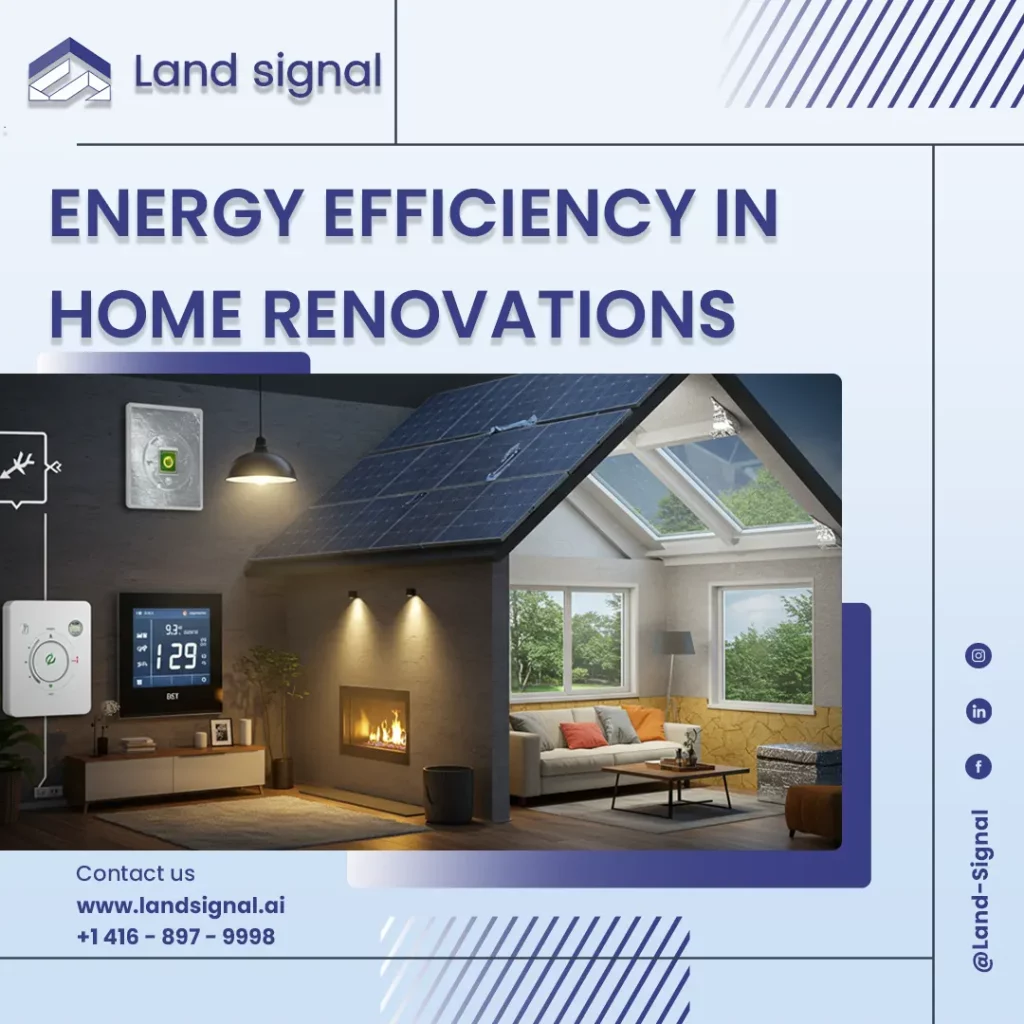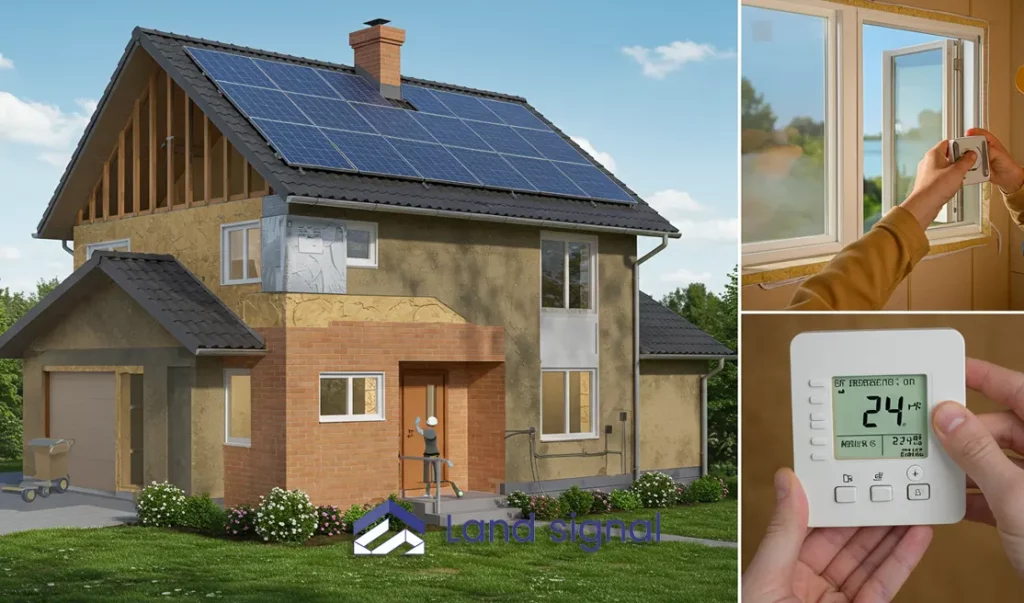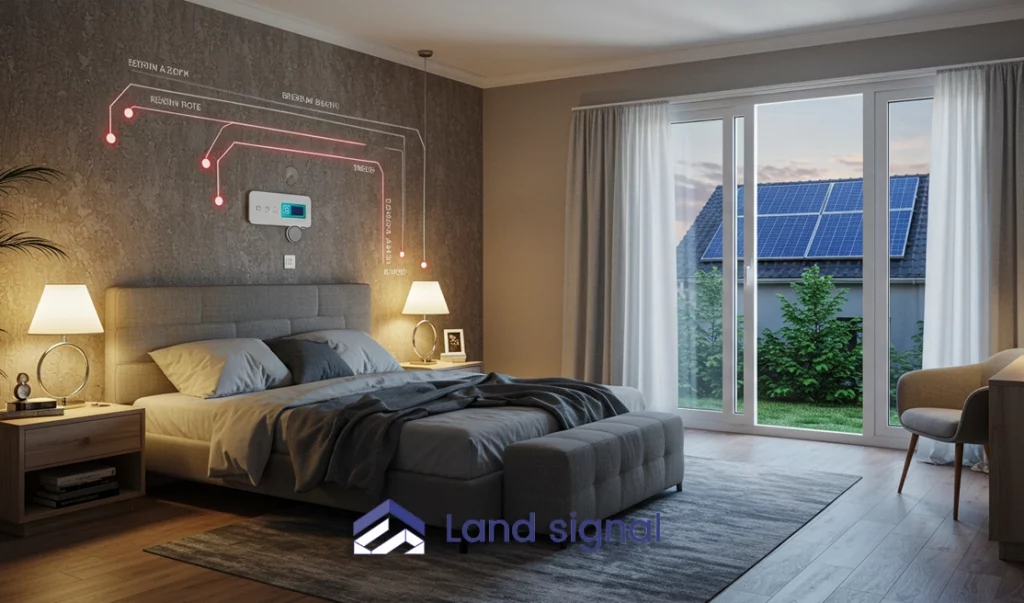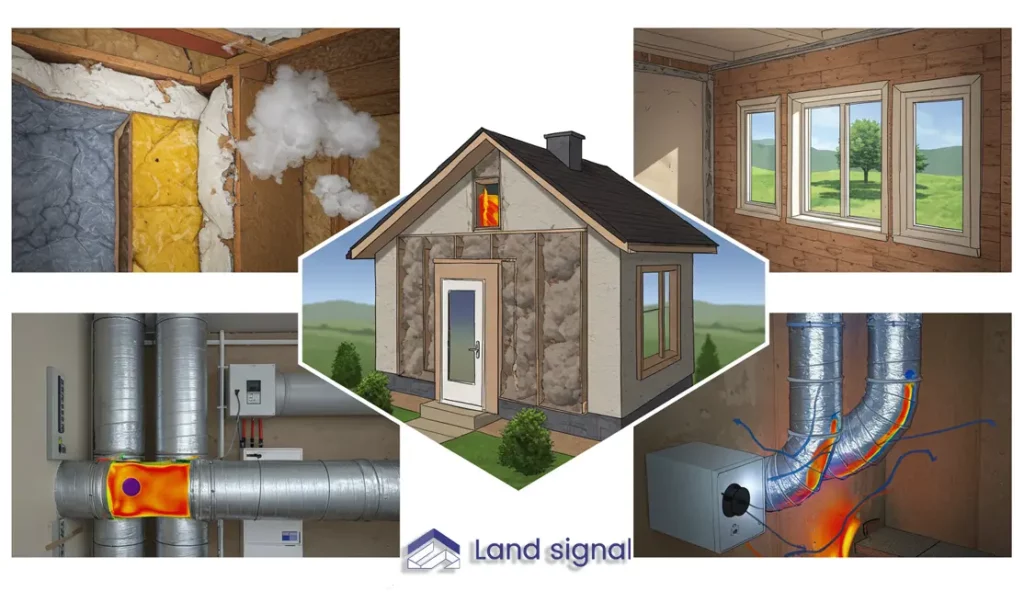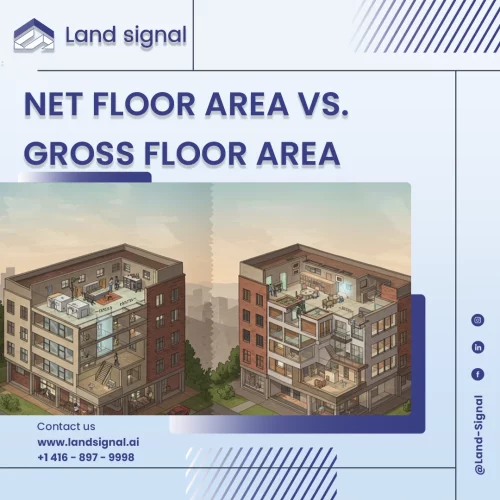Renovating your home offers a valuable opportunity to improve both its functionality and energy efficiency. As energy costs rise and environmental concerns grow, making energy-efficient choices in your renovation projects has become increasingly important. From upgrading insulation and windows to installing energy-efficient HVAC systems and renewable energy solutions, these improvements reduce your environmental impact and can lead to long-term savings.
Land Signal is here to support your renovation by helping you secure the necessary construction permits and providing a comprehensive online construction cost calculator. With our tools and expertise, you can ensure your project complies with all regulations and is effectively budgeted.
This article will guide you through key considerations for energy-efficient home renovations, covering everything from cost factors to required permits and common mistakes to avoid.
Start Your Project with Confidence
At Land Signal, we assist with construction and renovation permits, as well as Garden House and Laneway Suite designs. Let our experts guide you through every step.
Why Energy Efficiency in Home Renovations is Important?
Energy efficiency in home renovations is crucial for several reasons. It reduces energy consumption, lowering utility bills and saving long-term costs. It minimizes environmental impact by reducing greenhouse gas emissions and promoting sustainable practices.
It enhances home comfort by improving insulation, reducing drafts, and optimizing temperature control. It increases home value by making the property more attractive to environmentally conscious buyers. In a world facing increasing energy demands and climate change challenges, prioritizing energy efficiency in home renovations is not just a responsible choice but a necessary one.
Read Also: Net Zero Home Toronto | A Complete Guide
Benefits of Energy Efficiency in Home Renovations
Cost Savings Over Time
- Reduced utility bills: Energy-efficient renovations significantly reduce energy consumption, resulting in lower monthly utility bills for heating, cooling, and electricity. The extent of savings depends on the scope of the renovations and the specific energy-efficient measures implemented. Upgrading insulation, installing energy-efficient windows, and optimizing HVAC systems can lead to substantial reductions in energy usage and corresponding cost savings.
- Long-term ROI: While energy-efficient renovations may require upfront investments, they offer a significant long-term return on investment (ROI). The reduced energy costs over time offset the initial investment, resulting in net savings over the lifespan of the improvements. Furthermore, energy-efficient homes often command higher market values, further enhancing the ROI.
- Environmental Impact: Energy-efficient renovations significantly reduce a home’s environmental footprint. By consuming less energy, homes contribute less to greenhouse gas emissions, mitigating the effects of climate change. Sustainable building practices and the use of eco-friendly materials further minimize environmental impact. Reducing reliance on fossil fuels promotes a cleaner and healthier environment for present and future generations.
Read Also: Calculate Your Home Renovation Costs Toronto
Key Considerations for Energy Efficiency in Home Renovations
Insulation
Proper insulation is crucial for minimizing heat transfer between the interior and exterior of a home. Adequate insulation in walls, attics, and basements reduces energy loss during winter and heat gain during summer, optimizing temperature control and reducing the workload on HVAC systems. Different insulation materials, such as fiberglass, cellulose, and spray foam, offer varying levels of thermal resistance (R-value).
Choosing the right insulation material and ensuring proper installation are essential for maximizing energy efficiency. Consider using insulation with higher R-values in colder climates. Ensure proper air sealing around insulation to prevent air bypass and reduce thermal bridging. Consult with a qualified insulation contractor to determine the optimal insulation strategy for your home.
Read Also : Renovation Permit Toronto | Everything You Need to Know Before You Build
Energy-Efficient Windows and Doors
Windows and doors are significant sources of energy loss in homes. Replacing old, drafty windows and doors with energy-efficient models can significantly improve insulation and reduce energy consumption. Look for windows with low-E coatings, multiple panes, and gas fills for enhanced insulation. Choose doors with tight seals and weather stripping to minimize air leaks.
Consider the window’s U-factor, which measures heat transfer, and the Solar Heat Gain Coefficient (SHGC), which measures how much solar heat is transmitted. Properly installed windows and doors with high-quality frames and insulated cores can significantly improve energy performance.
Efficient Heating and Cooling Systems
Heating and cooling systems account for a substantial portion of a home’s energy consumption. Upgrading to high-efficiency HVAC systems, such as heat pumps or geothermal systems, can significantly reduce energy usage and lower utility bills. Regular maintenance and proper sizing of HVAC systems are essential for optimal performance and energy efficiency.
Consider zoning systems to control temperatures in different areas of the home independently. Ensure ductwork is properly sealed and insulated to minimize energy loss. Regularly replace air filters and schedule annual maintenance checks for optimal performance.
Renewable Energy Sources
Incorporating renewable energy sources, such as solar panels or solar water heaters, can further reduce a home’s reliance on fossil fuels and minimize environmental impact. Solar panels generate electricity from sunlight, offsetting electricity consumption from the grid.
Solar water heaters use solar energy to heat water, reducing the need for conventional water heating systems. Explore government incentives and rebates for renewable energy installations. Consult with a qualified solar installer to assess the feasibility and potential cost savings of solar energy systems.
Lighting and Appliances
Lighting and appliances contribute to a home’s overall energy consumption. Replacing incandescent bulbs with energy-efficient LED lighting can significantly reduce electricity usage. Choosing Energy Star-certified appliances ensures they meet stringent energy efficiency standards. Use smart lighting controls and occupancy sensors to further optimize lighting energy use. Consider purchasing appliances with advanced energy-saving features, such as sleep modes and variable speed motors.
Home Energy Audit
Conducting a professional home energy audit before starting a renovation project can identify areas of energy waste and provide recommendations for improvements. An energy audit assesses a home’s insulation, air leakage, and HVAC system performance, providing valuable insights for maximizing energy efficiency. A home energy audit can help prioritize energy-efficient upgrades and identify cost-effective solutions. The audit report typically includes recommendations for insulation improvements, air sealing, and HVAC upgrades.
Proper Ventilation
Proper ventilation is essential for maintaining indoor air quality and preventing moisture-related issues. Installing energy-efficient ventilation systems, such as heat recovery ventilators (HRVs) or energy recovery ventilators (ERVs), can ensure adequate ventilation while minimizing energy loss.
Proper ventilation removes excess moisture, pollutants, and odors from the home, improving indoor air quality. HRVs and ERVs exchange heat between incoming and outgoing air, reducing energy loss associated with ventilation. Bathroom and kitchen exhaust fans should be vented directly outdoors to prevent moisture buildup.
Sustainable Materials and Practices
Green Building Materials
Using green building materials, such as recycled or sustainably sourced lumber, bamboo flooring, or low-VOC paints, minimizes environmental impact and promotes healthy indoor air quality. Green building materials are often made from renewable resources and have lower embodied energy, reducing their overall environmental footprint.
Consider using reclaimed wood, recycled glass countertops, or sheep’s wool insulation for sustainable and aesthetically pleasing options. Look for certifications like Forest Stewardship Council (FSC) for wood products and Cradle to Cradle for various building materials. By choosing green building materials, homeowners can reduce their carbon footprint and contribute to a healthier indoor environment.
Water Conservation
Incorporating water conservation measures, such as low-flow toilets, showerheads, and faucets, reduces water consumption and lowers water bills. Water-efficient landscaping practices, such as drought-tolerant plants and rainwater harvesting systems, further conserve water. Install dual-flush toilets and consider greywater recycling systems for irrigating gardens and lawns.
Choose permeable paving materials to reduce runoff and allow for groundwater recharge. By implementing water conservation measures, homeowners can contribute to water conservation efforts and reduce their environmental impact.
Common Mistakes to Avoid in Energy-Efficient Renovations
1. Choosing cheaper, less sustainable options
While budget considerations are important, opting for cheaper, less sustainable materials or appliances can compromise long-term energy efficiency and cost savings. Investing in high-quality, energy-efficient products may have higher upfront costs but offers greater long-term benefits. Cheaper materials may have shorter lifespans, requiring more frequent replacements and negating any initial cost savings. Less sustainable options may also contribute to higher energy consumption and increased environmental impact over time.
2. Ignoring Proper Installation
Even the most energy-efficient products will not perform optimally if not installed correctly. Proper installation of insulation, windows, and HVAC systems is crucial for maximizing their energy-saving potential.
Hiring qualified and experienced contractors ensures proper installation and avoids costly mistakes. Improperly installed insulation can lead to thermal bridging and reduced effectiveness. Incorrectly installed windows can result in air leaks and drafts. Poorly installed HVAC systems can compromise efficiency and lead to higher energy bills.
3. Ignoring Air Leaks and Drafts
Air leaks and drafts can significantly compromise energy efficiency. Sealing air leaks around windows, doors, and other openings is essential for minimizing energy loss and improving comfort. Weather stripping, caulking, and spray foam insulation can effectively seal air leaks.
Conduct a thorough air leakage assessment to identify all potential sources of drafts. Use a blower door test to quantify air leakage and prioritize sealing efforts. Addressing air leaks can significantly improve energy efficiency and reduce heating and cooling costs.
4. Buying Appliances Without Energy Ratings
When purchasing new appliances, always look for Energy Star certification. Energy Star-certified appliances meet stringent energy efficiency standards, ensuring they consume less energy and lower utility bills.
Compare Energy Guide labels to assess the estimated annual energy consumption and operating costs of different appliances. Consider the long-term operating costs when making purchasing decisions, as more efficient appliances can lead to significant savings over time.
Conclusion
Energy efficiency in home renovations is a crucial consideration for creating comfortable, sustainable, and cost-effective living environments. By implementing energy-efficient strategies, homeowners can reduce their environmental impact, lower their utility bills, and enhance their home’s value. Careful planning, thorough research, and collaboration with qualified professionals are essential for a successful and energy-efficient home renovation project. By avoiding common mistakes and prioritizing sustainable practices, homeowners can maximize the long-term benefits of their renovations and contribute to a more sustainable future.

